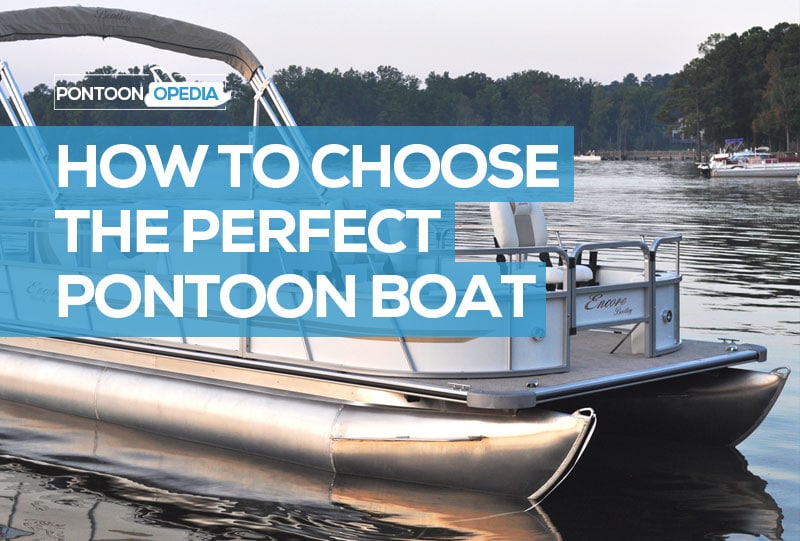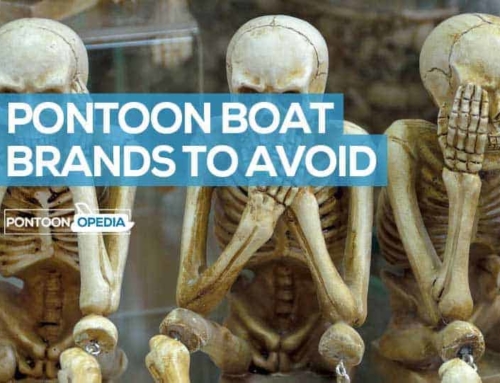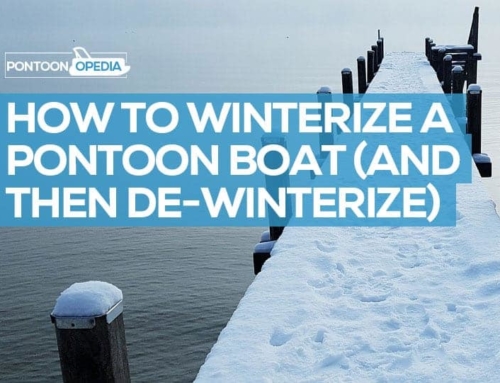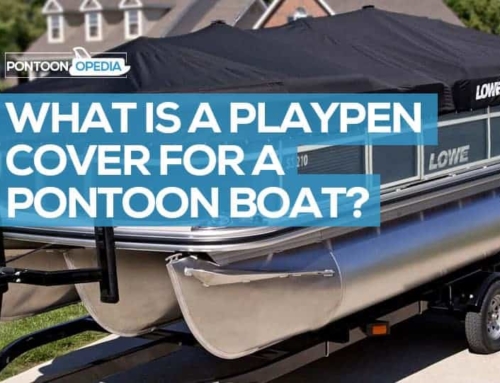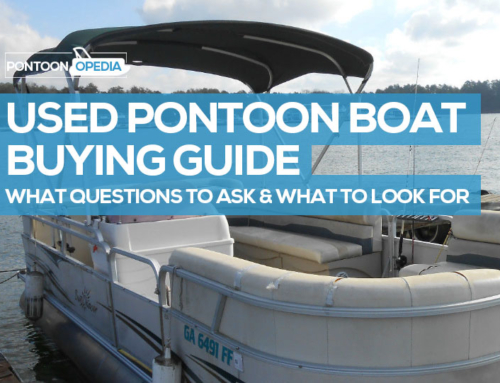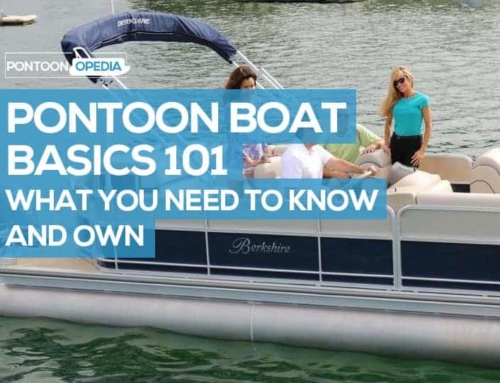This guide was originally produced by BoatReeds.com in a PDF print out format. As far as I can see it’s not available online anywhere nowadays, but still offers some fantastic advice to those thinking about buying a pontoon for the first time. At the end of the guide, I will also list out some additional resources that first-time buyers will find useful.
How to Choose the Right Pontoon Boat
Pontoon boats have changed! Pontoon boats are now great looking and can offer you and your family more fun and activities than virtually any other boat. They are big, wide open platforms where everyone can relax and have fun.
Pontoon boats are versatile, fun boats that glide smoothly along a river or across a lake. No “rock and roll” here ‐ their effortless performance pleases even the most demanding captain and crew.
Comfortable, plush party boats by day or night, with big inviting lounges and the luxury of large deck space for sunbathing, fishing, swimming, tubing, skiing, wakeboarding, picnicking or just cruising around. A pontoon boat can do it all for you and your family!
This report can help you find just the right pontoon boat.
This guide has been written by avid pontoon boat users as an informational source for the family which is considering the purchase of a pontoon boat. The more you know about pontoon boats, the greater the chance you will make a good decision about which pontoon boat to purchase and where to purchase that boat.
In many ways the uses of the boat are the same, but the ways the boats are designed and built are very different. Before discussing the actual structures of a pontoon boat let’s first consider what size might be best for you.
There will be many factors that will influence your decision but, initially, the main considerations should be where the boat will be used, by how many people and just what activities they will be involved in.
When you answer those questions you’ll have a good idea of what you should be looking for.
Let’s Consider the Size
- 16’ – 19’ Deck: Usually used on small lakes. Calm water. Can hold 4 – 6 people.
- 20’ – 22’ Deck: This size will work well on most rivers or lakes. If there will be waves or other boat traffic be sure to get tubes with a diameter of 25”. This size will accommodate 6 – 10 people very comfortably.
- 23’ – 25’ Deck: Offering even more room and an improved ride in rough water situations. Tube diameter should be at least 25”. Handles 6 – 15 people.
- 26’ – 30’ Deck: Very big boat. Usually purchased for only specialized situations.
Note: Many manufactures measure the length of the pontoon boat differently. The deck length and tube length should be considered separately. Always compare the deck lengths. The deck will provide the useable space on the boat whereas the tubes will provide the capacity and the performance of the boat. Avoid a deck that sticks out from the front of the tubes. It will cause the boat to perform to a substandard level and it may nose dive.
Now that you have considered what size boat will be best, how will you be using the boat? The use will determine the engine size needed and also some of the option choices. The next chart should give you an indication of the engine you will need.
| General Cruising | Tubing | Water Skiing | |
|---|---|---|---|
| 16 to 19 foot deck | 25 to 40 hp | 40 to 50 hp | 50 hp + |
| 20 to 20 foot deck | 40 to 60 hp | 50 to 70 hp | 70 hp + |
| 23 to 25 foot deck | 40 to 70 hp | 60 to 90 hp | 100 hp + |
| 26 to 30 foot deck | 70 hp + | 90 hp + | 130 hp + |
Note: A third pontoon can be added down the middle of the boat. A “triple ‐ toon” or tritoon is a newer option that gives a pontoon boat more buoyancy so it can handle more people, rougher water and higher horsepower engines. A “triple ‐ toon” can also increase speed so your wakeboarding, and water skiing capability will be enhanced.
Fishing off of a pontoon boat can be a lot of fun for young and old.
A pontoon boat can be rigged with fishing seats, live wells, fish locator, rod holders, trolling motors, and much more.
Before buying your new boat, think about how much time you will actually spend fishing.
Don’t buy too much fishing equipment. It will only get in the way of the other activities when you are not fishing.
Perhaps this chart below will help your decision.
Fishing Will Constitute What Percentage of Your Time On the Boat if Any?
- 60% or more – Choose a fishing or cruising model with at least 2 fishing chairs, live well, and fish locator.
- 40% to 60% – Cruising model with 2 fishing chairs on front deck, live well, and fish locator.
- 20% to 40% – Cruising model and possibly 2 removable fishing chairs.
- Less than 20% – Any pontoon boat will make a good fishing platform.
A pontoon boat gets very good performance for its length and the size of the normal engines.
We are often asked how fast a pontoon boat will go.
The actual miles per hour will vary greatly based on the weight of the boat, equipment, people and the condition of the water. The chart below will give you a “rough” approximation of your speed depending upon engine choice and length of boat.
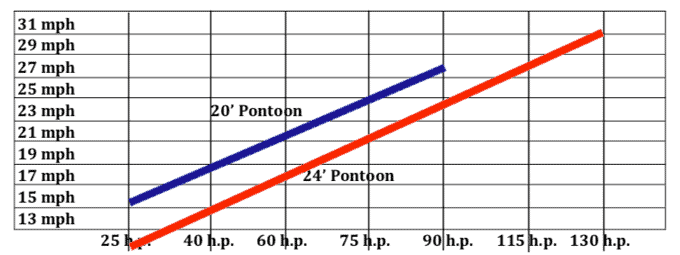
This is a rough guide to what speeds you can reach depending on pontoon length and engine size.
What Does a Pontoon Boat Cost?
That is an important question and I am sure that you are interested in the answer. Unfortunately, it is like asking, “What does a car cost?” .
There are almost an endless amount of variables depending on brand, options, quality, horsepower, etc. It would be very hard for us to state flatly ”This is the price!”.
In order to put you in the “ballpark” let’s imagine a new 20’ pontoon boat with a 40 hp 4‐stroke engine and the normal equipment. A boat like this would probably sell around $16,000 to $18,000 in the lower quality brands. The average quality pontoon of this size sells for $20,000 – $22,000.
You can explore some average prices from the different brands by clicking this price guide for both new and used boats.
The highest quality boats with higher horsepower and all the “bells and whistles” would be $25,000 or more.
Your family might be able to enjoy almost any pontoon boat in the beginning.
But if you plan to own it more than four or five years be sure to stay away from the “low end” boats that won’t stand up very well. Also, buy enough horsepower at the start. It is very expensive to add speed later on.
A new boat, or a used one, is very easy to finance. It is common to put 10% – 20% down and finance the balance for 5 to 10 years. That would put payments on a very nice new boat at approximately $200 ‐ $250 a month.
You should also consider how much your pontoon boat is going to depreciate in value once you buy it.
What Makes a Good Quality Pontoon Boat?
Now that you have (hopefully) decided on what size pontoon boat you will be searching for, how are you going to tell which ones are good quality and which ones are not so good? It could be difficult but we will now cover the design and construction details so that you’ll be prepared when you start to compare boats.
The design of the pontoon boat you will purchase is very important for many reasons. The amount of detail the manufacturer has put into the design of the boat can tell much about both the boat as well as the manufacturer that produced that boat.
Note: Here is a list of the top pontoon boat manufacturers that I would personally recommend to a first time buyer.
If a manufacturer takes the time and care to design a boat that looks superior to the competition, it is likely they have taken some care with the overall construction of the boat. The designs of the tubes, tube brackets, cross members, railings, consoles and furniture is all very important.
Good design is the first sign of value and quality!
The design and styling of the boat are not areas you should ever overlook. If the boat was designed properly, the fit and finish of th e boat will show. It is extremely important to inspect both construction and “fit and finish” of a pontoon boat.
Most pontoons look great from above but let’s start at the bottom and work our way up.
The Design of the Pontoons
Beneath each pontoon there should be a keel strip to add strength and to protect the pontoon.
The tube itself comes either circular or U ‐ shaped.
We think the circular is stronger the same way a pipe is stronger than a U ‐ shaped gutter. Besides, the U‐shaped pontoons are not waterproof so they have to put foam on the inside. The foam eventually absorbs water causing the boat to get heavier and lose performance. They say the U ‐ shaped pontoon carries more weight with less drag, but we think that is a debatable benefit compared to the potential future problems.
Get the circular tubes, but be sure they are “chambered” or divided into at least three sections.
This is a safety item.
Also be sure they are vented and have a drain at the back to allow condensation to escape. The better ones are at least 80” thick.
The Nose of the Pontoon
Now look at the “nose” of the pontoon. Does it look strong and re‐enforced (is it at least .90”?) . It will have to absorb most of the wave action. Be sure the spray fins are not just welded on because they will eventually crack off. The fins should be an integrated part of the “cap” over the nose piece. Check to see if all the welding is clean and even over the entire boat.
The Deck and Flooring
The part of the boat that has to absorb the most stress is the area between the deck (floor) and the pontoons.
The boat is constantly subjected to movements and “twisting” as it rides up and down and flexes in the waves.
The brackets holding the circular pontoons to the flat deck are crucial. Be sure they are extruded aluminum (not bent) in an “M” shape and properly welded.
Also make sure that the bracket has a wide base where it meets the pontoon. This provides more area for proper welding. This will be the strongest type of bracket and probably never cause you any problems.
The deck is made up of four areas; the cross member, decking material, gunnel moldings and deck fasteners. The cross member should be every 24 inches and also be mounted the full width of the decking material, insuring support over the entire width.
This design is the strongest available!
The deck should be no less than seven ply 3⁄4” pressure treated marine grade plywood and carry a lifetime warranty.
The gunnel materials should be made of the highest quality anodized aluminum. Anodizing the aluminum insures that your boat will look good for years and not turn black. The gunnel moldings should be bolted through the cross members, not pop riveted. This will insure a solid construction.
The corners should be re‐enforced and rounded. Square corners or corner covers will catch docks and piers while mooring.
The decks should be fastened with stainless steel tech fasteners, not “nuts and bolts.”
The pre ‐ drilled oversized bolt holes allow water to penetrate up around the bolts and cause the wood to separate, rot and get weak. Usually, to save money there aren’t enough bolts used so the deck eventually will warp. Another problem with nuts and bolts is you will periodically have to re ‐ tighten them.
Note: An available deck option is to get an aluminum floor. The aluminum wil l last forever but it is noisier, less flexible and not as comfortable to walk on as wood ‐ that’s the reason your house floors aren’t aluminum. We advise getting a wood deck as long as it is thick enough and has a Lifetime Guarantee.
A very good use for aluminum is back at the transom. The motor causes an extreme amount of flexing and water turbulence. A wood transom will eventually rot away and need replacing. Look to get a complete aluminum transom for trouble -free operation.
Special Note: Be sure the carpet is of very high quality and at least 22 oz. grade. Rub your hand over it and through it. Be sure the fibers are strong and dense. The carpet will have to take the most “traffic” and it is very expensive to replace. Also make sure it has at least a 5 year fade and mat resistant warranty.
The Pontoon Boat Railings
The railings on a pontoon boat should be at least 1 1⁄4” x 1 1⁄4” 5‐wall tubing and have at least a .090 wall thickness. The 5 wall tubing will provide you with a quieter and more solid railing system. The paneling type material should be installed with an anti‐vibration product, like foam tape, and sandwiched into the tubing. This will provide the strongest and quietes t railing system.
Avoid some of the common and less expensive ways which are stapling or pop rivets. The railing should also be anodized entirely, including the welds. Much like the gunnel molding the rails will also quickly turn black. If it is not anodized it will rub off on your hands and clothes and reduce the value of the boat.
Another very important feature to look for are railings that are raised up slightly above the deck. This is very important, because it provides drainage as well as ventilation for the boat. Raised up railings have proven to prevent mildew and save boaters many hours of cleaning time each season.
Many manufacturers have wooden furniture framework as standard on some models.
Furniture and Seating
Common problems associated with wooden furniture frames are rotting, mold, mildew, and the frame work falling apart, due to the amount of water the furniture frame and the foam absorbs. Most manufactures put up to a lifetime warranty on these frames, but what they do not tell you is that the warranty only covers rotting and termite attack, not mold, mildew or the framework from falling apart.
The frame style that has become known as the best is a Rotational Molded Plastic seat frame. Some manufacturers even offer double wall roto‐mold furniture, which is strong enough to stand on and because of the dual walls, speakers and wiring are protected and concealed. This structure has been proven over many years to be the best in every way.
In addition to the plastic frame work, the seat cushions, sundeck cushions and console frames all should be constructed out of a non‐rot and non‐absorbing material, like plastic or fiberglass. These construction materials are more expensive to use and install, but will last forever. The plastic and fiberglass materials are stronger and much easier to maintain. The furniture and console frames are not the only parts you should concern yourself with.
The vinyl and foam are ad are also very important. The vinyls should be at least 33 oz. This will insure that your upholstery will withstand your normal wear and tear for many years of enjoyable boating. The vinyl need to be UV protected so the sun does not break them down. The foam underneath the vinyl should be high density, to prevent breakdown. Don’t compromise on the furniture.
Good furniture will be comfortable to sit on, look nice year after year and enhance your re‐sale value – particularly if you have a great looking captain’s chair.
Look at the Warranties Available
A pontoon boat is a major purchase, so the amount of time you will use the boat is important. If the boat is not reliable, the purchase is less rewarding to you as a boater. So, the importance of a good dealer and how helpful their service department is to you increases the value.
We all hope there will not be a problem, but what if there is one? How good is the warranty?
Most warranties do not cover what most people are lead to believe. So it is up to you as a customer and then as an owner to know what is covered under the warranties of that boat. As a helpful aid, here are a few of the obvious loop holes to watch out for.
First, most wood warranties do not cover much. Depending on the manufacturer, most do not cover labor of replacement after the first couple years. The wood warranties for furniture type items are almost always voided due to improper care of the boat. (“The customer left the boat damp or full of water!”) .
The ideal warranty would cover at least 10 years of 100% of both parts and labor guaranteed.
This should cover both the deck and the furniture items from not only rot, but against structural failure. That is a common problem for most companies using wood in their furniture frames.
The second major area of concern covers the welds on the tubes and railings. The welds should be guaranteed for 20 years, covering both parts and labor 100%.
Only strong and knowledgeable manufacturers will back a product for a long period of time.
Thirdly, is the warranty for the carpets and vinyl. These areas should be backed with a 5‐ year warranty. The furniture and carpets are most of what people see when you look at a pontoon and are expensive and difficult to replace.
13 Questions to Ask When Shopping for a Pontoon Boat
- Does the boat fit your needs for size and seating?
- How is the overall design and construction of the boat?
- Are the furniture frames made out of wood or the better roto‐molded?
- Are the railings 1 1⁄4” x 1 1⁄4” x .90 anodized rails?
- Are the deck fasteners installed to prevent warping?
- Are the tubes both air‐filled and chambered?
- Is there any wood in the transom?
- Does the boat look good? Both generally and “fit and finish?”
- How good is the warranty?
- How long are the tubes warranted for 100% parts and labor ?
- How long are the railings warranted for 100% parts and labor??
- How long is the furniture frames warranted for 100% parts and labor?
- How long is the deck warranted for 100% parts and labor?
We hope this report has been helpful for both you and your family. We’ve tried to combine everything you should know about buying a pontoon boat into one, convenient report. Hopefully if helps you avoid mistakes and enables you to find a boat you’ll be very happy with for many, many years.
For even more information on what to look for in the perfect pontoon boat for you and your family, I would also recommend that you read the Pontoonopedia Buyer’s Guide.
Also, once you have purchased your first pontoon, I would highly recommend that you take a look at the recommended gear suggestions available on Pontoonopedia. I have spent years testing, trialling, and using virtually every conceivable product that you can imagine in the pontoon boat world.
In my recommended gear section I only highlight the products and accessories that provide the best value and come with the highest reviews, not just from me, but also other boaters in the pontoon boat community.
See you on the lakes and happy pontooning!

